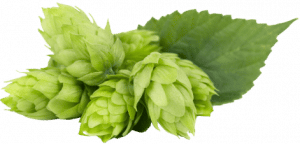Hop Terminology

Hop Terminology · Aroma
Hop Terminology – Understanding the Basics – Much is spoken of the quality and intensity of dried hop aroma. These are strong varietal characteristics. There appears to be a general relationship between the type and heaviness of a hop aroma and the flavour and aromatic properties of beer.
A major component of the soft resins. When isomerized, these materials provide the main bitter compounds associated with beer. The alpha acid content varies widely among hop varieties from levels of 3 – 4% w/w in aromatic type hops to levels of 13 – 16% in the bitter hops.
A soft resin component, beta-acids are not bitter in the natural or isomerised form. However, some oxidation products add bitterness, and beta-acids can be chemically transformed into light-stable bittering compounds.
The alpha acids exist in three analogous forms, humulone, ad-humulone and co-humulone; and the proportions of these analogues vary markedly with variety. Varieties with relatively low co-humulone levels are strongly favored.
Storagability
Where available, analytical figures on varietal sheets show the % of Alpha Acid remaining after 6 months storage at 68f. Oxidation of alpha acids removes their ability to be isomerized to the required bitter isomers. In comparable circumstances, some varieties lose a greater proportion of their alpha acids to oxidation than others do. Cold storage and anaerobic conditions can delay oxidation. Some oxidation of essential oil components is necessary to produce compounds thought to be important in beer flavors, so controlled ageing is important for hops required for both bittering and aromatic properties.
Total Oil
This hop characteristic varies widely with seasons, varieties and growths from 0.5 mls to about 3 mls per 100g of hops. While the soft resin compounds are responsible for providing the bitterness to a beer, the quantity and composition of the essential oils are responsible for the amount of hop flavor and aroma in the beer.
Myrcene, Humulene, Caryophyllene & Farnesene
The four major components of the essential oils, when referring to hop terminology. Between them they account for about 60 – 80% of the essential oils for most varieties. These compounds are highly volatile hydrocarbons, and boiling the wort drives off most, if not all, of them. As a result, they contribute little to hop flavor and aroma in beer. Therefore, it is usually necessary to add late hops for additional aroma.
Whole Hop (Raw cones of the plant Humulus Lupulus)
With our unique combination of vacuum Packed “Freshpaks” (Charles Faram Hop Terminology) in 5kg and 20kg packs and our comprehensive stock of over 100 different varieties from growers worldwide, all year round we can offer the brewer an artist’s pallet of flavors to create every type and style of beer.
Type 90 Hop Pellets (Hops milled/ground into powder then pelletised)
The most popular varieties come in Type 90 pellets, sealed in vacuum packs. Brewers add them during the boil for bittering or later on for aroma. They must be used in conjunction with a whirlpool or enhanced filtering system.
Hop Terminology · Aroma
Much is spoken of the quality and intensity of dried hop aroma. These are strong varietal characteristics. There appears to be a general relationship between the type and heaviness of a hop aroma and the flavour and aromatic properties of beer.
Hop Terminology · Alpha Acid
A major component of the soft resins. When isomerised, these materials provide the main bitter compounds associated with beer. The alpha acid content varies widely among hop varieties from levels of 3 – 4% w/w in aromatic type hops to levels of 13 – 16% in the bitter hops.
Hop Terminology · Beta Acids
A soft resin component, beta-acids are not bitter in the natural or isomerised form. However, some oxidation products add bitterness, and beta-acids can be chemically transformed into light-stable bittering compounds.
Co-Humulone
The alpha acids exist in three analogous forms, humulone, ad-humulone and co-humulone; and the proportions of these analogues vary markedly with variety. Varieties with relatively low co-humulone levels are strongly favoured.
Storagability
Where available, analytical figures on varietal sheets show the % of Alpha Acid remaining after 6 months storage at 68f. Oxidation of alpha acids removes their ability to be isomerised to the required bitter isomers. In comparable circumstances, some varieties lose a greater proportion of their alpha acids to oxidation than others do. Cold storage and anaerobic conditions can delay oxidation. Some oxidation of essential oil components is necessary to produce compounds thought to be important in beer flavours, so controlled ageing is important for hops required for both bittering and aromatic properties.
Total Oil
This characteristic varies widely with seasons, varieties and growths from 0.5 mls to about 3 mls per 100g of hops. While the soft resin compounds are responsible for providing the bitterness to a beer, the quantity and composition of the essential oils are responsible for the amount of hop flavour and aroma in the beer.
Myrcene, Humulene, Caryophyllene & Farnesene
The four major components of the essential oils, when referring to hop terminology. Between them they account for about 60 – 80% of the essential oils for most varieties. These compounds are highly volatile hydrocarbons, and boiling the wort drives off most, if not all, of them. As a result, they contribute little to hop flavor and aroma in beer. Therefore, it is usually necessary to add late hops for additional aroma.
Whole Hop (Raw cones of the plant Humulus Lupulus)
With our unique combination of vacuum Packed “Freshpaks” in 5kg and 20kg packs and our comprehensive stock of over 100 different varieties from growers worldwide, all year round we can offer the brewer an artist’s pallet of flavours to create every type and style of beer.
Type 90 Hop Pellets (Hops milled/ground into powder then pelletised)
The most popular varieties come in Type 90 pellets, sealed in vacuum packs. Brewers add them during the boil for bittering or later on for aroma. They must be used in conjunction with a whirlpool or enhanced filtering system.

